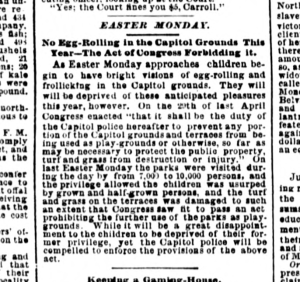Have a drink at: The White House Egg Roll
Mr. President, can we play in your yard?
Ask Rutherford B. Hayes about: Inviting 600 kids over for Easter
It was 1876. Congress was debating expenditures, and they were in a pickle over the Capitol grounds – every year at Easter, the place was swamped with kids and families rolling dyed eggs down the hills. This in and of itself was ok, but the overall ruckus made a mess of the lawn, and Congress’ landscaping budget was totally dry for the year. Plus, this was an age where cattle still routinely grazed in downtown D.C. and people were totally freaking out the cows.
So Congress, in its characteristic fun-loving spirit, proposed a solution in the form of “An act to protect the public property, turf and grass of the Capitol grounds from injury,” reading:
It shall be the duty of the Capitol police on and after April 29, 1876, to prevent any portion of the Capitol Grounds and terraces from being used as playgrounds or otherwise, so far as may be necessary to protect the public property, turf and grass from destruction or injury.
The President was on board, and the Capitol Building Turf Protection Act was enacted on April 21, 1876. You may now in your mind picture Ulysses S. Grant shaking his fist and shouting, “Hey you kids, get off my lawn!”

Story goes, in 1877 it rained on Easter so no one had reason to see if Congress was really serious about the ban. But in 1878 when there was a good forecast and it looked like there would indeed be a crackdown on rolling eggs at the Capitol, kids marched straight up to President Rutherford B. Hayes and asked if they could come play in his yard instead (literally). Hayes said yes, and the White House Easter Egg Roll was born.
By 1880 it was a shindig, with the Evening Star noting that “The children took absolute possession of the grounds south of the White House to-day….The pump near the White House was a never-failing source of amusement and dampness. There must have been at least between five and six hundred children celebrating Easter Monday in the grounds.”
The occasion has been held most every year since (it was suspended on food conservation grounds in 1918, with WWI in full swing) and only grown – this year the Obamas expect 35,000 to attend.
(P.S. Yes, I too now want Chinese takeout after reading the phrase “egg roll” so many times.)
Fun Facts:
The Capitol Building Turf Protection Law is still on the books, by the way, and they still take it seriously. Only in January of this year did legislative action permit legal sledding on Capitol grounds, stating:
“The Committee understands the need to maintain safety and order on the Capitol grounds and commends the Capitol Police for their efforts. However, given the family-style neighborhood that the Capitol shares with the surrounding community the Committee would instruct the Capitol Police to forebear enforcement of 2 U.S.C. 1963 (`An act to protect the public property, turf, and grass of the Capitol Grounds from injury’) and the Traffic Regulations for the United States Capitol Grounds when encountering snow sledders on the grounds.”
The turf protection bill was introduced by Vermont Congressman Justin Smith Morrill, who notably served 43 years in the Senate and was more notably the architect of an incredible law that provided more than 17 million acres in land grants to the states for the creation of public universities.
Egg rolling is often attributed (in error) to Dolley Madison. No one has a totally solid handle on when it started, but there’s some evidence that informal White House egg parties were around during Lincoln’s administration, when the president’s son Tad enjoyed rolling eggs with a friend.
John Philip Sousa not only attended the event, but later wrote Easter Monday on the White House Lawn in tribute.
Additional Reading:
Don’t miss the White House’s great photo gallery with pictures going back to the 19th century.
The White House Historical Association and the National Archives go into detail about the Egg Roll and its history.
Learn more about First Ladies’ participation in the festivities with a five-part series from the National First Ladies’ Library.
Read primary accounts by searching the Library of Congress’ awesome Chronicling America database (look for the National Republican of March 28, 1877 and the Evening Star, March 29, 1880).
